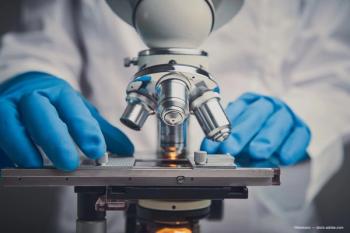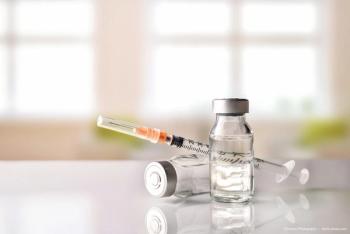
Groundbreaking research unlocked mystery of tissue drag
The problem of tissue drag, which once plagued ophthalmic surgeons, is largely a thing of the past?thanks to groundbreaking work conducted several decades ago by Leonard Apt, MD, currently professor of ophthalmology at the Jules Stein Eye Institute, University of California, Los Angeles (UCLA).
Editor’s Note: In its Nov. 1, 2006 commemorative issue, Ophthalmology Times celebrates its 30th anniversary with contributions from ophthalmologists and their review of ophthalmic advancements over the past 30 years. Leonard Apt, MD, professor of ophthalmology, Jules Stein Eye Institute, University of California, Los Angeles, shares his discovery of tissue drag-a problem that once plagued ophthalmic surgeons during strabismus surgery-and the recommended solutions. His article (“Oiling synthetic absorbable sutures reduces ‘tissue-drag’ ”) was the lead cover story in Ophthalmology Times’ inaugural issue in November 1976.
Los Angeles-The problem of tissue drag, which once plagued ophthalmic surgeons, is largely a thing of the past-thanks to groundbreaking work conducted several decades ago by Leonard Apt, MD, currently professor of ophthalmology at the Jules Stein Eye Institute, University of California, Los Angeles (UCLA).
In 1976, Dr. Apt and Andrew Henrick, a medical student at UCLA, published an article on tissue drag with what were at the time the two new absorbable synthetic sutures, Dexon (Davis & Geck) and Vicryl (Ethicon Inc.).
Dr. Apt had earlier conducted research on what he suspected was an allergic reaction to catgut sutures used in eye muscle surgery. While other physicians theorized that infection or surgical trauma was responsible for the irritation, swollen eyelids, pain, and itching that some patients had been experiencing following strabismus surgery, Dr. Apt leaned toward a different theory.
Using tiny slivers of suture placed intradermally on the forearm of patients at the time of surgery, he conducted skin tests and found that 32% of the patients who had a reaction in the eye following eye surgery also experienced a positive reaction to the piece of plain catgut. In a second study using chromic catgut, 21% of the patients had a positive skin test. Collagen sutures also produced an allergic response.
After evaluating Dr. Apt’s findings, suture manufacturers switched to using synthetic absorbable materials for their sutures. While the new suture materials introduced in the early 1970s addressed the allergy issue, another arose-which was that the synthetic sutures had a tendency to attract adjacent tissues when passing the suture through tissue, a phenomenon that Dr. Apt called tissue drag.
“We found under a very high magnification that the surfaces of these sutures were not smooth,” said Dr. Apt, who also is founding director emeritus of the division of pediatric ophthalmology at UCLA. “They had numerous irregularities and many tiny hooklets coming off the surface of the suture. These hooklets were catching adjacent tissue and dragging it in as the surgeons were inserting the needle.”
Tissue drag reduced easy passage of the suture through tissue, made tying knots difficult, and prevented secure knot-tying when strands of tissue were incorporated into the knot.
Having discovered the surface irregularities on the Dexon and Vicryl sutures, Dr. Apt and Henrick then experimented with a variety of absorbable liquids as coating on the surface of the sutures to smooth them before passing through the tissue in simulated operating room conditions. The liquids used in testing included isotonic saline, methylcellulose (0.5%, 1%, and 2.5% solutions), polyvinyl alcohol (1.4%, 3%, and 6% solutions), glycerine, and two low-viscosity absorbable vegetable oils-peanut and sesame.
The investigators found that coating the sutures with peanut or sesame oils produced a smooth, thin layer over the surfaces that remained for at least 15 minutes. With the coating, the sutures passed easily through tissue, drag was reduced, and there was no impact on knot tying.
In their study, Dr. Apt and Henrick recommended that the suture manufacturers reduce tissue drag by either smoothing the surface during the manufacturing process or developing an absorbable coating. Davis & Geck and Ethicon concurred with the findings and recommendations of the study. Subsequently, Davis & Geck produced a Dexon (polyglycolic acid) suture with a smoother surface, while Ethicon coated its Vicryl (polyglactin 910) sutures with polyglactin 370.
“Both measures improved the sutures with regard to handling, ease of passage through tissue, knot tying, and tissue drag,” Dr. Apt said. Smoothing and coating have almost eliminated the problems surgeons experienced some 30 years ago, he added.
In 1999, Dr. Apt received the first Distinguished Achievement Award from Ethicon Inc. for his research in allergy to catgut and collagen surgical sutures and subsequent investigations leading to the development of present-day surgical absorbable sutures now used worldwide. His former medical student and co-author Dr. Henrick is in private practice in Orange County, CA, as a general ophthalmologist and oculoplastic surgeon.
Both brands of improved sutures were the most popular synthetic sutures used in ophthalmology for a decade or so following their introduction, but Ethicon’s coated Vicryl sutures have become the dominant synthetic absorbable suture in recent years, according to Dr. Apt. At the Jules Stein Eye Institute, where he works, the most popular surgical suture is the braided, coated polyglactin 910 suture; only a small amount of plain and chromic catgut is now used.
Other brands that have a small share of the market for synthetic absorbable sutures are the Biosorb sutures (Alcon Laboratories) and the Polysorb and Dexon II (Syneture), all of which are made of polyglycolic acid with polycaprolate coating. Syneture’s Dexon S is an uncoated polyglycolic acid suture.
A few other synthetic absorbable sutures are now available, including polydioxone (PDS), polyglyconate (Maxon), and poliglecaprone (Monocryl). To date, these sutures have not had a significant role in ophthalmic surgery.
The combination of manufacturing processes that smooth the surface of sutures and the use of synthetic, nonallergenic materials for surface coatings have made ophthalmic surgery much easier, according to Dr. Apt.OT
Reference
Apt L, Henrick A. “Tissue-drag” with polyglycolic acid (Dexon) and polyglactin 910 (Vicryl) sutures in strabismus surgery. J Ped Ophthalmol 1976;13:360-364.
Newsletter
Don’t miss out—get Ophthalmology Times updates on the latest clinical advancements and expert interviews, straight to your inbox.



















































.png)


